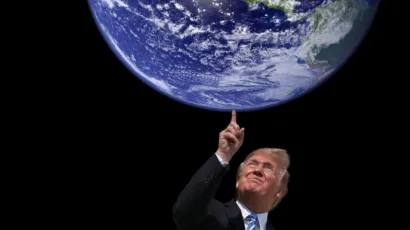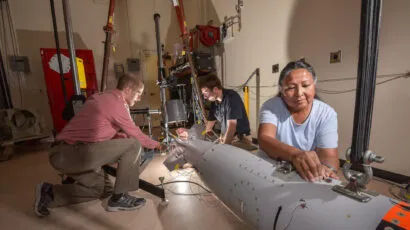A neglected climate strategy: Empower women, slow population growth
By Laurie Mazur | October 12, 2009
Trillions of mirrors launched into space to deflect the sun’s rays. A massive fleet of ships churning up sea spray to increase Earth’s cloud cover. As political responses to climate change limp along, scientists currently are debating these and other geoengineering schemes to stabilize the climate. Yet, as many have observed, such schemes carry formidable costs–and risks.
In contrast, there are sensible, low-tech ways to reduce our collective carbon footprint for relatively little cost, at far less risk, and with substantial social benefits. Voluntarily slowing population growth is one of them.
“Population growth” isn’t synonymous with “population control”–the top-down programs that have trampled human rights and health in pursuit of lower birthrates, notably in India and China. Today, there is a broad global consensus that the best way to slow growth is by ensuring that all people are able to make real choices about childbearing. That means access to voluntary family planning and other reproductive-health information and services. It also means empowering girls and women through education and employment opportunities.
Population growth has largely disappeared from the global agenda, and most people assume the “population bomb” has long been defused. But while the rate of population growth has slowed in most parts of the world, the global population still increases by 75-80 million people every year, the equivalent of adding another United States to the world every four years or so. A certain amount of future growth is inevitable, but choices made today will determine whether human numbers–now at 6.8 billion–climb to between 8 billion and 10.5 billion by mid-century.
The difference between 8 and 10.5 billion is significant–especially for the Earth’s climate. Indeed, researchers have found that slower population growth could make a substantial contribution to mitigating climate change. To put this into perspective, consider the Socolow and Pacala “wedge” approach to reducing greenhouse gas emissions. Socolow and Pacala compare a business-as-usual emissions trajectory to one that would stabilize climate at a safer level. The gap between those trajectories is divided into pie-shaped “wedges”–each representing an action begun today that would eliminate 1 billion tons of CO2 per year by 2050. Seven slices are needed to avert disastrous change, and Socolow and Pacala estimate that stabilizing world population at 8 billion (rather than 9 billion or more) would provide one–or even two–“wedges” of emissions reductions.
These findings may seem counterintuitive. After all, climate change is mostly caused by greenhouse gas emissions in the industrialized world, where population growth rates are low. And most population growth is taking place in the developing countries, where per-capita emissions are a fraction of ours. So how can slower population growth help solve the climate crisis?
The answer lies in the future. The developing countries are where the lion’s share of population growth will occur, and they also are where development must occur if half of humanity is going to escape from grinding poverty. Affluent countries are able to reduce emissions by curbing the vast amounts of waste in their systems of production and consumption. But developing countries aren’t likely to raise their standards of living without increasingly intense resource usage, and therefore greater emissions.
In that light, the benefits of slower population growth are twofold: Slower growth can spur development in low-income countries by enabling families and governments to make essential investments in development and social services. At the same time, a smaller population will help limit the environmental damage that development brings. A smaller population does not guarantee sustainability, but it would be easier to provide food, freshwater, and energy–at less environmental cost–to a population of 8 billion, rather than 10.5 billion.
Slower population growth is not a quick fix for climate change; its full impact wouldn’t be felt until the second half of this century. And, of course, slowing population growth is not all we must do. Continued reliance on fossil fuels could easily overwhelm any carbon emission reductions from slower growth. It may be tempting to focus on population growth in the developing countries rather than grapple with energy use in the developed world, but the West can’t be let off the hook. Americans are by far the world’s largest per-capita emitters of CO2; changing our own systems of production and consumption must be the top priority if we are to preserve a habitable planet.
Still, slowing population growth is a piece of the “pie”–it’s part of what we must do to avert catastrophic climate change. And everything we have to do to slow population growth is something we should be doing anyway.
Family planning and women’s empowerment are vitally important in their own right, as a matter of human rights and social justice. They also have far-reaching benefits for individuals and societies. For example, preventing unintended pregnancies could reduce maternal deaths by 25 percent, saving the lives of 150,000 women and girls each year. And when girls go to school, they marry later and have fewer, healthier children. Girls’ education has also been linked to higher per-capita income, better crop yields, lower HIV infection rates, and reduced infant mortality.
Family planning and girls’ education can help with climate change mitigation by slowing population growth. But it can also contribute to adaptation by improving public health, economic well-being, and women’s empowerment–crucial building blocks of resilience.
Despite the myriad benefits of these programs, the world’s countries have yet to muster the resources to pay for them. Fifteen years ago, at a United Nations population conference in Cairo, 179 countries agreed on a plan to slow population growth by the ethical means outlined above. But while developing countries are spending about half of what they promised in Cairo, the donor countries have provided less than a quarter of the promised funding. As a result, some 200 million women worldwide lack access to family planning services, and girls’ education–especially at the secondary level–is far from universal.
Perhaps the specter of climate change will finally motivate governments to keep their promises. Indeed, when viewed as an emissions abatement strategy, the Cairo plan is a terrific bargain. For example, the developed countries’ share of the cost to provide reproductive health services for every woman on earth is $20 billion–about what the bankers on Wall Street gave themselves in bonuses last year. The U.S. share of the cost is $1 billion, less than 2 percent of what the United States will spend on the war in Afghanistan this year. In contrast, the scheme to launch mirrors into space is estimated to cost a few trillion dollars.
Geoengineering and other high-tech strategies may yet have a place in the climate mitigation toolbox. But while we explore these high-cost, high-risk interventions, let’s not neglect low-tech, high-reward strategies like reproductive health and women’s empowerment. Before we launch mirrors into space, we have important work to do here on Earth.
Together, we make the world safer.
The Bulletin elevates expert voices above the noise. But as an independent nonprofit organization, our operations depend on the support of readers like you. Help us continue to deliver quality journalism that holds leaders accountable. Your support of our work at any level is important. In return, we promise our coverage will be understandable, influential, vigilant, solution-oriented, and fair-minded. Together we can make a difference.
Topics: Climate Change, Opinion















